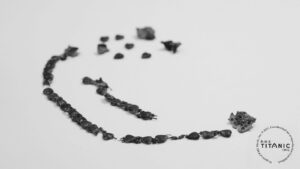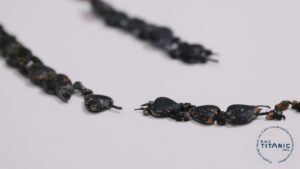Written by Alexandra Klingelhofer, Reviewed by Ross Mumford
 Conservation, as defined by the American Institute for Conservation, is the profession “devoted to the preservation of cultural property for the future.” When it comes to archaeological artifacts, conservation means examining and treating materials recovered from excavations to enhance our knowledge of the past and the context around each artifact. This work involves analysis, documentation, research, and treatment. This rewarding profession allows for making new discoveries, preserving ancient artisanal works, learning how materials were used, and broadening the interpretation of cultural groups and their possessions, all for the benefit of the public. The Black Glass Necklace is the latest Titanic artifact to become part of this important work.
Conservation, as defined by the American Institute for Conservation, is the profession “devoted to the preservation of cultural property for the future.” When it comes to archaeological artifacts, conservation means examining and treating materials recovered from excavations to enhance our knowledge of the past and the context around each artifact. This work involves analysis, documentation, research, and treatment. This rewarding profession allows for making new discoveries, preserving ancient artisanal works, learning how materials were used, and broadening the interpretation of cultural groups and their possessions, all for the benefit of the public. The Black Glass Necklace is the latest Titanic artifact to become part of this important work.
As an archaeological conservator with degrees from the University of North Carolina—Chapel Hill and the University of Southampton, U.K., I have worked on artifacts from both terrestrial and marine environments on six continents. These experiences provided me with a broad education in cultures, materials, and human history, which proved useful when I accepted the position as Executive Director of Collections for RMS Titanic Inc. in 2008. In 2020, I transitioned into my current role as Conservator of Record. My 17 years of curatorship, conservation, and research have led to important contributions to Titanic’s legacy.
While assessing and conserving Titanic’s collection are always important goals, my main research focus is to reveal artifacts and their stories within globally shared exhibitions. As Conservator of Record, I provide oversight and advice on how best to preserve the collections while conducting both remedial and new treatments for artifacts as recommended by the current collections staff.
Among the artifacts the expedition team recovered in 2000 was an interesting trapezoid-shaped soft mass, called an accretion, meaning a loose assembly of artifacts held together by products of corrosion and deterioration. Recovered materials are not always identifiable immediately and require additional assessment in a laboratory. In 2013, the conservation team initially examined the accretion to identify its various components, including possible parts of a box camera, a Gillette razor and wrapper, strips of paper, and loose heart-shaped and spacer beads. Conservators removed and conserved the Gillette wrapper while leaving the remaining items together.
 Years later, the collections curator presented me with the desalinated, still-wet accretion for treatment to stabilize the other objects and resolve questions about the camera and beads embedded in this mass held together by a slurry, or watery mixture, of debris and sediment. I focused first on identifying the materials and creating a treatment plan. The materials were easily identifiable as cardboard, copper alloy, leather, wood, metal, rubber, and glass, but the purpose of each was not entirely clear. After assessment, the curator and I discussed possible treatments to determine the best plan to achieve our mutual goals for the artifacts.
Years later, the collections curator presented me with the desalinated, still-wet accretion for treatment to stabilize the other objects and resolve questions about the camera and beads embedded in this mass held together by a slurry, or watery mixture, of debris and sediment. I focused first on identifying the materials and creating a treatment plan. The materials were easily identifiable as cardboard, copper alloy, leather, wood, metal, rubber, and glass, but the purpose of each was not entirely clear. After assessment, the curator and I discussed possible treatments to determine the best plan to achieve our mutual goals for the artifacts.
I approached the small collection of artifacts and debris as a mini excavation, which I conducted using magnification and hand tools. I first photographed the entire assemblage to record its initial condition. Several pieces were loose, including most of the camera parts (except for a round metal gear), a pouch with a closed two-part copper alloy snap, and beads held together by deterioration debris. Beginning with the cardboard element, I removed each object separately then cleaned, documented, and photographed it. I removed the loose heart-shaped beads and faceted spacer beads one by one, cleaned them, and placed them in separate containers. Finally, I mechanically sifted the slurry in place and moved it to one side, which left only the solid aggregate.
Interestingly, this small aggregate had something protruding from it. Inside the matrix of deteriorating organic material, I was excited to discover additional beads still strung together, potentially fragments of a beaded necklace. I determined that the previously removed artifact with a snap[AK5] possibly formed the corner of the small pouch for the necklace. The deteriorated metal, leather, and wood elements appeared to have created a barrier around the necklace, protecting it from complete deterioration. The more difficult process was excavating the necklace segments mechanically from the solid matrix that held them.
 Using specialized hand tools, I gently excavated the covering matrix following the line of the beads into the center. This is an intensely focused activity for a conservator, which involves [AK6] continually making assessments and decisions about which tool to use, what angle to work from, and how to avoid damaging the string while still releasing the beads. It appeared the necklace had been deposited in a jumble, causing stress on the string and breaking it in several places. As the excavation proceeded, I recovered necklace segments and carefully placed them aside in water for further cleaning. I kept samples of the covering matrix in water for further research to identify the materials more specifically.
Using specialized hand tools, I gently excavated the covering matrix following the line of the beads into the center. This is an intensely focused activity for a conservator, which involves [AK6] continually making assessments and decisions about which tool to use, what angle to work from, and how to avoid damaging the string while still releasing the beads. It appeared the necklace had been deposited in a jumble, causing stress on the string and breaking it in several places. As the excavation proceeded, I recovered necklace segments and carefully placed them aside in water for further cleaning. I kept samples of the covering matrix in water for further research to identify the materials more specifically.
With mechanical removal, the adhering debris separated relatively easily from the glass bead surfaces. Each matte-black heart bead contained two stringing holes from each lobe to either side of the point. The beading pattern featured hearts alternating point to point and lobe to lobe, with three hexagonally faceted spacer beads separating each heart along the strand.
Although the string was relatively fragile, the glass beads were stable even with small accretions remaining. Surface corrosion products partially stabilized the entire necklace construction. Consolidating the string with organic stabilizers allowed us to mount the necklace sections onto a new support. The curator and I worked together and determined not to fully clean all the stable glass surfaces but instead to present the segments in the hope of sharing with visitors the feelings of discovery and excitement that arise as treatment gradually reveals an artifact.
Recovering jewelry is always exciting, but once conservation is completed, more questions emerge. Are the necklace beads black as a fashion statement, or are they mourning jewelry? The beads appear to be molded glass, or French jet—a common material in industrial Victorian and Edwardian England. Based on the lengths recovered, the artifact appears to be a period necklace, perhaps a choker or a longer strand. But was there more? Can its source be identified? Was it contained in a box or bag? What is its relationship to the other recovered artifacts in the assemblage? What else can this single artifact tell us?
The legacy of Titanic’s artifacts lies in the fact that they can still inform us about the Ship and the people on board. Excavating this necklace confirms my belief that each artifact has a story to tell—it is a matter of finding it. Over the years, small, seemingly insignificant clues have provided insights into the body of Titanic artifact knowledge. It is a privilege to work on these artifacts and know that while they are being preserved, they are also teaching us more about Titanic.
